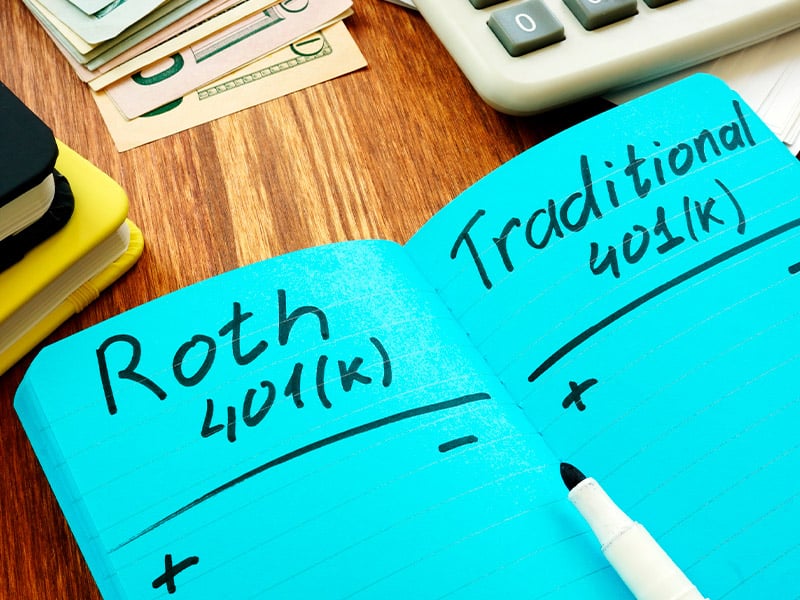Written by Prio Wealth Advisor, Kelley Ellis
and Prio Wealth Relationship Manager, Robert Devinney, CFP®
Employees are often presented with an option to save for retirement through their employer’s sponsored retirement plan. New and seasoned employees should review their employer’s retirement plan at least annually to review their contribution options, investment elections and if they are meeting the employer matching program. In fact, one option you may be faced with is choosing between a Traditional 401(k) and/or a Roth 401(k). You may have heard about both and how they are favorable vehicles to jumpstart your retirement savings, but it can be challenging to choose one of the two. Before you make your decision, it is important to know the difference between the Traditional 401(k) and the Roth 401(k). Let’s review the pros and cons of each and then discuss which may be the appropriate option for you.
Traditional 401(k)
The Traditional 401(k) is a well-established and well-known employer sponsored retirement savings account. This option allows you to defer a pre-tax portion of your paycheck for retirement savings. The amount that you choose to defer will not be included in your overall taxable income and will effectively reduce your taxes paid each year. An employee may contribute up to $20,500 into a 401(k) for 2022, and if you are age 50 or over, you may contribute an additional $6,500 which is known as a “catch-up contribution.”
The savings in your 401(k) can be invested in any one or combination of investment options provided by your employer’s plan. The other key benefit of a Traditional 401(k) is that you will not pay any taxes on the growth of this money until you begin withdrawing from the account in retirement. Once you begin to rely on these assets for income, the withdrawals made will be taxed at your ordinary income tax-rate.
Roth 401(k)
Logistically speaking, a Roth 401(k) and Traditional 401(k) are quite similar. The Roth 401(k) is an employer sponsored retirement savings account, and an employee may contribute up to $20,500 for 2022 (plus the catch-up contribution for employees over age 50). The contributions may be invested and grow tax free. But this is where the differences between a Roth 401(k) and Traditional 401(k) begin: taxes. Contributions made to a Roth 401(k) are added to your taxable income for the year, and you pay taxes on the annual contribution. However, when you ultimately make withdrawals from the Roth 401(k), they are completely income tax free. The idea is that, instead of reducing your income tax liability year-over-year, you are paying taxes today on the future growth of your retirement plan and thus reducing your income tax liability in retirement.
Which one should you choose?
Choosing between a Traditional 401(k) and a Roth 401(k) generally depends on two things. The first one is your current income and the tax bracket into which that falls. If you are in a lower tax bracket now but will be in a higher bracket when you retire, the Roth 401(k) would make the most sense. If the reverse is true, then a Traditional 401(k) may be most suitable for your situation. The second factor is time. The longer you have until retirement, the more it makes sense to pay the taxes today and let your contributions grow tax-free and compound. Please remember that it is important to review your options with a tax consultant prior to choosing any one path.
Why not both?
This is a great question, and the answer is: why not both? Creating both taxable and tax-free income in retirement offers optionality. Keep in mind that your annual maximum contribution is still limited to 20,500 total in 2022, but that can be allocated between the two types of accounts in any amount that you prefer.
It is important to remember that retirement savings decisions can be reviewed and reallocated periodically. Therefore, it is just as important for a current employee to review their employer retirement plan as it is for a new employee. Not only can you change the amount of your contributions or the investments within your retirement account, but you can change from the Roth 401(k) to the Traditional 401(k) and vice versa at any time down the road.
Let Prio Wealth help you plan & strategize
Given that employer retirement plans typically come with more than a few variables and options, we suggest you contact your Wealth Advisor to discuss the most suitable retirement savings strategy for you.
| This document has been prepared by Prio Wealth LP (“Prio Wealth”) for informational and educational purposes only and not as investment, legal or tax advice. This document reflects the opinions of Prio Wealth and it is based on information that we believe to be reliable at the time of publication. However, Prio Wealth does not guarantee the accuracy and completeness of any sourced data. Opinions expressed herein are not intended to provide personal advice and do not take into account the unique investment objectives and financial situation of the reader. This document is not an offer to sell or a solicitation of an offer to buy any security and does not constitute a representation as to the suitability or appropriateness of any security or financial product. Prio Wealth cautions the reader that investments in securities involve risks and that past results are not indicative of any future performance. |
